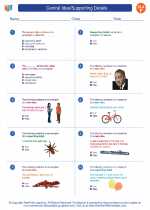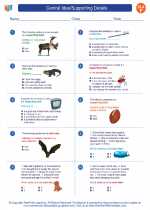Central Idea/Supporting Details
Understanding the central idea and supporting details is crucial for comprehending a text's main message and the evidence that backs it up. The central idea is the most important point the author is trying to make, while supporting details provide specific information that reinforces and develops the central idea.
Central Idea
The central idea is like the heart of the text. It's the main point that the author wants to communicate to the reader. Finding the central idea involves identifying the key concept or message in the text. To do this, look for repeated words or phrases, the main topic of each paragraph, and the overall tone of the text. Sometimes the central idea is explicitly stated, while other times it's implied and requires careful inference.
Supporting Details
Supporting details are the specific pieces of information, evidence, or examples that help to develop and reinforce the central idea. These details can include facts, statistics, quotations, examples, and anecdotes. They provide the "meat" of the text and give substance to the central idea by offering proof and elaboration.
Study Guide
- Read Actively: When reading a text, pay attention to key words and phrases, and note any patterns or repetitions.
- Identify the Main Idea: Determine the main point or message the author is trying to convey.
- Look for Supporting Details: Seek out specific evidence, examples, or explanations that back up the central idea.
- Summarize: Write a brief summary of the central idea and the most important supporting details in your own words.
- Practice with Texts: Use sample texts to identify central ideas and supporting details, and discuss your findings with a study partner.
Understanding the central idea and supporting details is essential for grasping the deeper meaning of a text. By honing these skills, you'll become a more perceptive reader and a sharper critical thinker.
[Central Idea/Supporting Details] Related Worksheets and Study Guides:
.◂English Language Arts Worksheets and Study Guides Sixth Grade. Central Idea/Supporting Details

 Worksheet/Answer key
Worksheet/Answer key
 Worksheet/Answer key
Worksheet/Answer key
